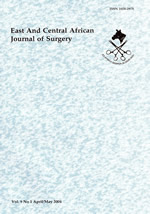
|
East and Central African Journal of Surgery
Association of Surgeons of East Africa and College of Surgeons of East Central and Southern Africa
ISSN: 1024-297X
EISSN: 1024-297X
Vol. 12, No. 1, 2007, pp. 24-29
|
 Bioline Code: js07005
Bioline Code: js07005
Full paper language: English
Document type: Research Article
Document available free of charge
|
|
|
East and Central African Journal of Surgery, Vol. 12, No. 1, 2007, pp. 24-29
| en |
Management of Club-Foot at Tikur Anbessa Hospital; Addis Ababa, Ethiopia.
Biruk, W.L.
Abstract
Background: "Club-foot", congenital talipus equinovarus (CTEV) is a common congenital anomalies encountered in paediatric orthopaedics. This study was aimed at determining the pattern and the short term outcome of management of CTEV in Ethiopian children seen at our Club foot clinic at TAH in Ethiopia.
Methods: All the 258 patients presenting to the club feet clinic in the study period from Dec.2003-Dec.2005 were studied. Patients in different age categories were treated with different protocols and the short term outcomes of these were compared. The assignment of the children into the different protocols was random and unintentional. Operated patients were followed separately.
Result: Three quarters (75.2%) of the patients were male and the mean age at the initial presentation was 8 months. Half of the children were first born. In 70.5% of cases, the disease was noticed at birth. Most (77%) of the patients came from urban areas and 62% of the mothers attended antenatal clinics. Prenatal ultrasound was done only for 86 (33%) of the mothers. The condition was bilateral in 46.5% of cases and there was positive family history in 29 (12%) children. In a quarter of the health institution born patients, the diagnosis was initially missed. Twenty six (10%) children were taken to bone setters. Thirty nine (15%) children had other associated congenital anomalies. Half of the patients did not have their first cast for more than three weeks after they were referred to the clinic. Only 60% of the patients requiring clubfoot shoes got them and this also took an average waiting period of 3-4 months. Maximum casting was 17 times. Posteromedial release was done in 46(12%) feet after the 8th cast (unless complete correction had been achieved earlier), in ages less than 6 months group, 63 (76.8%%) feet were completely corrected using the standard Ponseti method as compared to correction obtained only in 13 (14%) feet using Ponseti technique every month. This was statistically significant with chi-square of 62 and odds ratio of 20 at 95% CI .In the older ages, there was no statistically significant difference between using a short leg cast every month or each week. The results were poor.
Conclusion: Club foot can be effectively treated using appropriate conservative methods and the outcome is better the earlier it is started. Pre-natal screening, post-natal neonatal examination and educating the public will decrease the chance of missing the problem at an early age. Proper training to practice the Ponseti technique may increase its success rate. All modified methods from the standard Ponseti protocol have poor outcomes.. Availability of more separate club foot clinic centres and supply of the necessary medical equipment will lead to improved outcomes.
|
| |
© Copyright 2007 - East and Central African Journal of Surgery
|
|
